What is the solar wind?
At every moment, the Sun emits a continuous stream of ionized particles from its outer layer, known as the solar corona, at an incredible speed of up to 1200 km/sec. This phenomenon is referred to as the “solar wind”. The solar wind forms endless spirals that surround the Earth, extend into the space of the Solar System, and even reach beyond its boundaries. This type of emission can also be observed from other stars, in which case it is called the stellar wind. Therefore, the flow of particles from the Sun can be referred to as the stellar wind of the Sun without any error.
The Origin of the Concept
The understanding of the world around us is constantly evolving in the scientific community. Through the process of challenging previous dogmas and concepts, new perspectives on reality can emerge.
For a significant period of time, scientists believed that the outer layer of any star was static. In this model, gravitational forces would balance the pressure from nuclear and thermonuclear explosions, preventing the escape of streams of molten material into space.
Sidney Chapman, an English geophysicist and astronomer, was the creator and developer of the theory regarding the stability of the solar atmosphere during his era. The hypothesis he proposed caused a division within the astrophysical community, and it seemed as though this divide would continue into the present day. However, an individual emerged who completely and definitively disproved the renowned scientist’s beliefs.
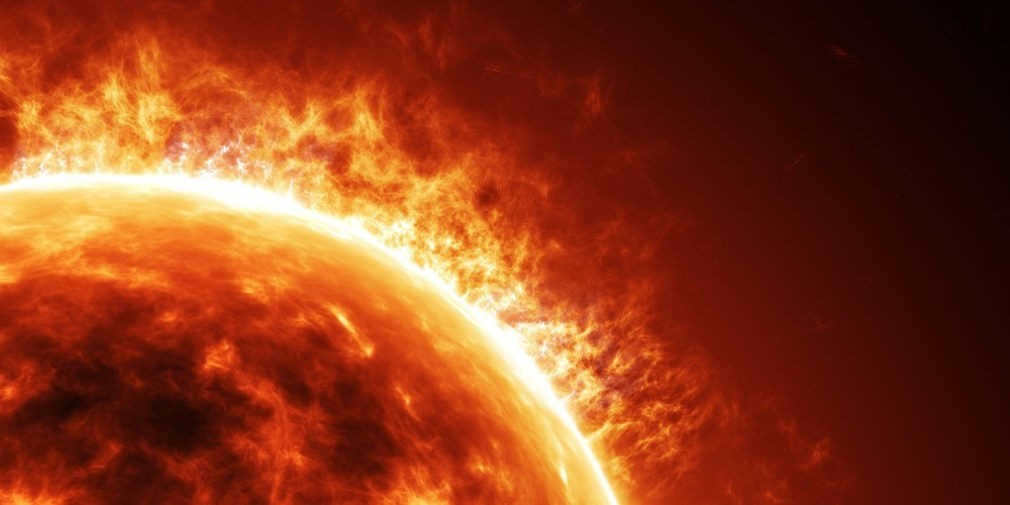
The individual known as Eugene Newman Parker is responsible for dealing a devastating blow to the theory proposed by his English counterpart. Through his groundbreaking research, he was able to provide evidence for the irreversible nature of matter emanating from the corona. Furthermore, he made a fascinating discovery: as the solar wind moves further away from the Sun, its velocity increases significantly, reaching supersonic levels, before eventually stabilizing and decreasing. Interestingly, the boundaries of the solar wind’s distribution have yet to be determined, eagerly awaiting their future explorers.
The findings of Y. Parker were subsequently corroborated by measurements taken by the initial interplanetary spacecraft. Subsequently, astronomers have also observed similar stellar winds in various galaxies scattered across the vastness of space.
What is the origin of the solar wind?
The solar wind originates from the continuous formation of plasma inside the Sun. This plasma is formed as a result of ongoing thermonuclear fusion reactions, which heat the core of the star to temperatures reaching several tens of millions of degrees Celsius. The highly heated and ionized gas then rapidly escapes from the Sun, extending far beyond our solar system.
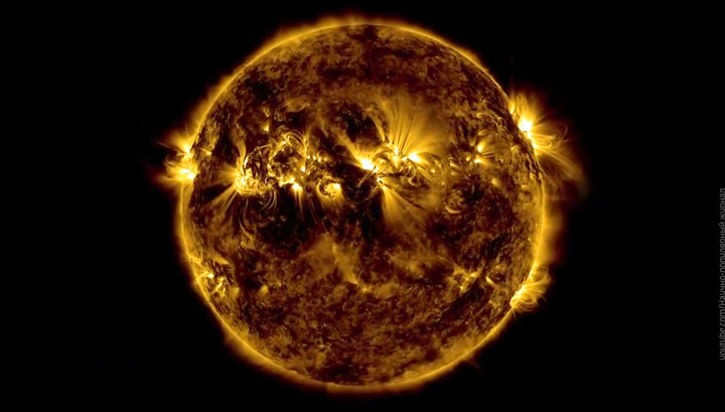
Did you know?: The boundaries of this volume result from the immense gravitational forces, “as if containing the explosions of numerous hydrogen bombs within a confined space,” caused by the colossal size of our star. It is 109 times larger than the Earth. As a result of this process, the Sun’s corona is heated to a temperature of one million degrees Celsius, caused by a series of plasma eruptions.
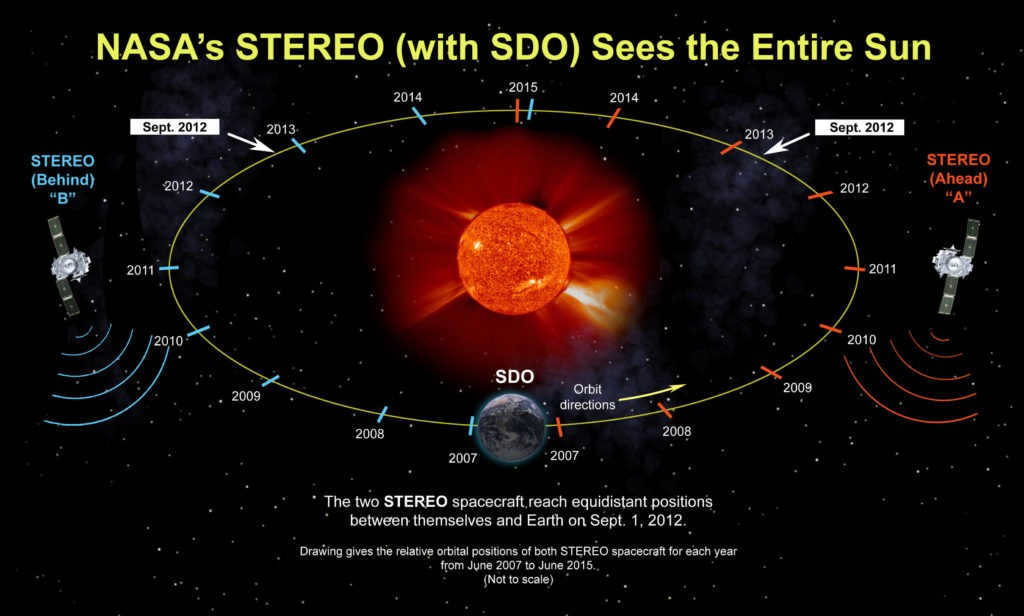
Exploring the Phenomenon
Prior to J. Parker’s discovery, Ludwig Biermann, an astronomer from West Germany, investigated the composition of comet tails and proposed the concept of corpuscular radiation originating from the Sun, which is now referred to as the solar wind. This flow of charged particles travels through areas on the surface of our star, known as coronal holes, where there is no magnetic field coverage, and escapes into outer space.
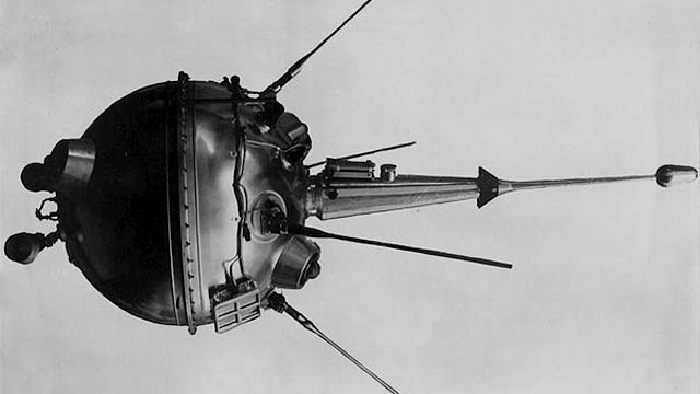

The Luna 2 automated interplanetary station.
After three years, the unique space phenomenon was studied extensively by the American satellite Mariner-2. The exploration of solar wind has been further advanced by the international station SOHO and various national space programs such as NASA in the USA. This has allowed the science of solar wind to expand its knowledge from the Sun’s surface to the outer boundaries of our star system.
Solar wind velocity
Measuring and studying the patterns of hydrogen plasma flow, which serves as the foundation of the solar wind, is of great scientific and practical significance.
Originally, particles of helium, hydrogen, iron, silicon, sulfur, and various other chemical elements are ionized and move at speeds ranging from 300-450 km/sec.
Fascinating fact: During solar flares or coronal mass ejections, the velocity of the flow increases, reaching up to 1200 km/sec! This transforms the solar wind into a “solar hurricane” and gives rise to a range of unique natural-physical phenomena.
The velocity of the solar wind flow continues to increase, reaching speeds of 400 to 800 kilometers per second in close proximity to Earth (where its acceleration ceases.) 1,500,000 kilometers per hour (420 km/sec) near Mars. At distances of up to 10 billion kilometers from the radiation source, the speed of solar charged particles is approximately – 1,000,000 km/hour (280 km/sec). Subsequently, it diminishes under the influence of the interstellar medium.
The motion of the solar wind is influenced by two factors: the gravitational force of the star and the pressure force within the stream. Calculations supported by practical research (missions of the American “Voyager-1, – 2” and “Pioneer-10, – 11”) have demonstrated the constancy of the velocity of differently charged particles beyond the orbit of our planet.
Categories of solar wind
The nature of the ionized stream from the Sun is organized and can be categorized into two groups:
Constant – Gradual
Gradual solar wind takes place within the core of the Sun, specifically in the equatorial region, when ionized gases undergo thermal expansion. This dynamic process propels the coronal plasma to supersonic velocities, reaching approximately 400 km/sec. In terms of its composition, the gradual stream is denser and broader than the rapid stream.
The source of the fast solar wind is coronal holes, which can release streams of this wind that persist for months. These streams periodically impact the Earth every 27 days, coinciding with the rotation of the Sun.
Disturbed
The disturbed flows occur due to the occurrence of coronal ejections and the presence of compression regions in interplanetary space prior to the arrival of coronal mass ejections or the fast solar wind.
Interplanetary shock wave
The occurrence of an interstellar shock wave is preceded by several events: the encounter of the fast solar wind with its slower counterpart, the collision between a charged stream of coronal particles and the Earth’s magnetosphere, the explosion of a supernova star, and the collision between galaxies.
Fascinating fact: Just six weeks ago, NASA made headlines for successfully measuring the strength of a shock wave caused by the solar wind. By strategically deploying four specially equipped multiscale satellites in space, American researchers were able to capture a moment of scientific fortune. This breakthrough not only provided highly accurate data about the nature and characteristics of solar particles, but also shed light on their motion.
A shock wave arises when a rapidly moving medium (such as gas) collides with an obstacle (such as the Earth’s magnetosphere) and causes a sudden alteration in the physical properties of the incoming flow (such as pressure, density, temperature, particle charge level, and other variables).
Propagation of the solar wind in space
As it moves away from its source, the Sun, the solar wind gradually loses strength and encounters several boundary regions. The first of these regions is located at a distance of 95 astronomical units (an astronomical unit is a unit of measurement equal to the average distance between the Earth and the Sun, approximately 149,598,100 ± 750 kilometers). This region is known as the “shock wave boundary,” where the solar wind undergoes a process called the deceleration of the solar wind, slowing it down from its initial supersonic speeds.
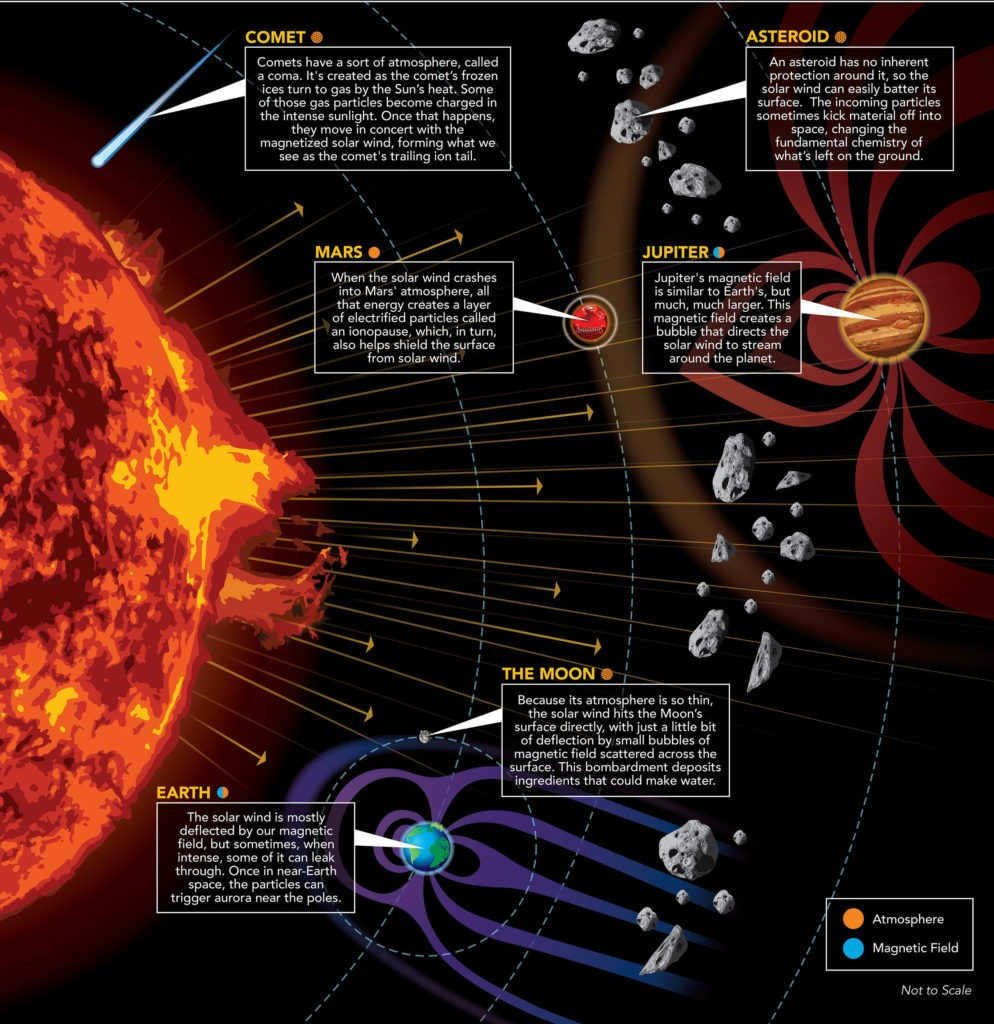
After traveling an additional 40 astronomical units (a.u.), the movement of charged particles is fully halted due to the influence of interstellar matter. This boundary, determined by astrophysical processes, is known as the heliopause. The region encompassed by the heliopause is referred to as the heliosphere. Its dimensions are not consistent:
Astrophysical information was gathered as a result of the launch of two American spacecraft series called “Voyager”, which were specifically designed to explore the outer limits of the solar system. More recently, Voyager 2 confirmed the data collected by Voyager 1.
Solar wind and its impact on Earth
The ever-changing streams of solar wind have the potential to devastate life on Earth’s surface. However, our planet is equipped with a robust defense mechanism known as the magnetosphere, which acts as a reliable shield against this formidable force. The balance between the solar wind and the magnetosphere is not constant, leading to frequent geomagnetic storms. This dynamic interaction between our planet and the solar wind is often referred to as “space weather,” as it reflects the real-time condition of Earth’s magnetic field. This term gained significance in 1990, highlighting the importance of understanding and monitoring these natural phenomena.
The founder of the field of heliobiology, which examines the effects of our sun on the life functions of organisms on Earth, was the Soviet scientist A. L. Chizhevsky. Due to his work and the contributions of other researchers, we have been able to uncover the patterns of how changes in solar activity affect the human body, crop yields, and the population dynamics of birds, fish, and animals.
The discovery and investigation of the Sun’s influence on Earth have revealed its cyclical nature. Regular reports now provide information on the activity level of the geomagnetic background. This allows individuals with chronic illnesses to take their medication at the right time. Additionally, modern agriculture has access to knowledge that enables them to conduct their activities in the most optimal manner. It is interesting to note that locusts coming to fields have been observed to follow the 11-year rhythm of the Sun by N.S. Scherbinsky.
Progress in science encourages young people to pursue it. Today, they have the opportunity to specialize in heliobiology by completing a degree at a specialized higher education institution.
The solar wind, as it travels around the Earth, gives rise to numerous natural phenomena. These include magnetic storms, auroras, and the planet’s radiation belts. Recently, it has become evident that the frequency of lightning is directly related to the increase in the influx of ionized particles from our star.
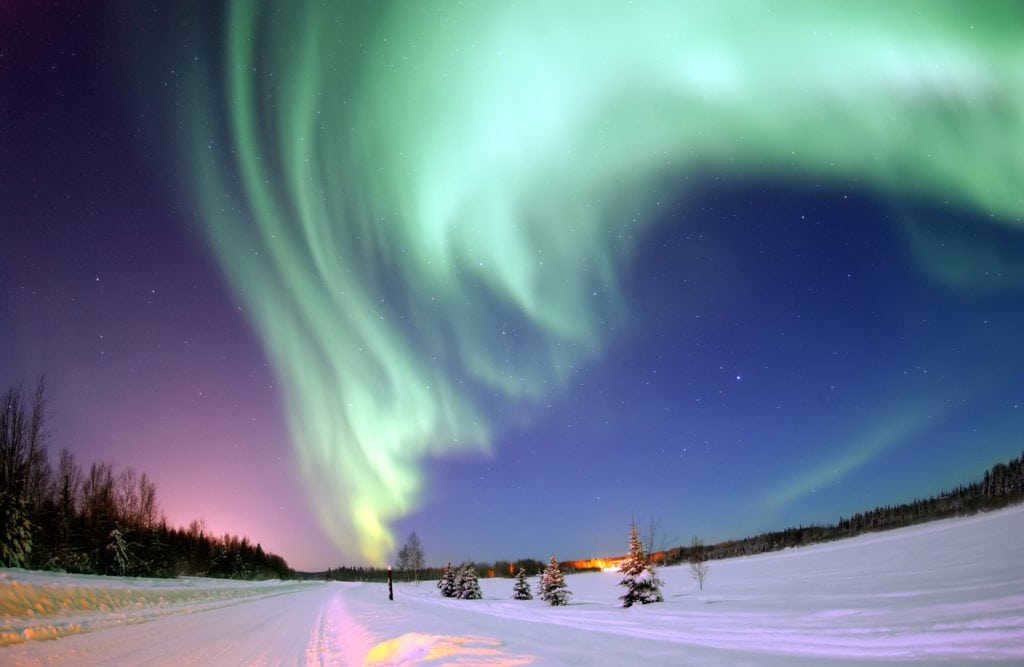
Solar wind generates various geophysical phenomena. In certain regions, there is an elevation in the emission of gaseous radon from the Earth’s surface, which can result in an upsurge in atmospheric radioactivity. A correlation exists between solar activity and the occurrence of earthquakes. The intensity of the electric field on the Earth’s surface is significantly altered during a magnetic storm, leading to fluctuations in atmospheric pressure.
Dangers posed by solar wind
The emissions emanating from the surface of the sun have the potential to disrupt radio communications, interfere with computer systems, cause malfunctions in engineering networks, and generate a harmful flow of electric current in metal structures and appliances.
The threats posed by solar wind attacks, which can lead to a wide range of problems, have necessitated the careful monitoring and forecasting of magnetic storms on Earth. Meteorological services across the globe are equipped with the necessary tools and constantly alert the public to fluctuations in the Earth’s magnetic field. Furthermore, technology has been developed to detect future seismic activity hotspots and warn the population of impending danger.
Did you know?: There is a scientific theory suggesting that water on the Moon’s surface may have originated from the impact of solar wind. The discovery of liquid water has sparked hope and optimism for future exploration of our closest space “neighbor”.
Possibilities for harnessing solar wind
Given the unique characteristics of the solar wind, it is intriguing to explore its practical applications.
Pekka Janhunen, a Finnish scientist, pioneered the development of the “electric sail” or “solar sail” concept, which involves spacecraft propelled by the energy of charged particles from the solar wind.
Therefore, it is imperative for humanity to contemplate its future and arrange for relocation to alternative worlds beyond our solar system. This is an unavoidable reality. Prominent intellectuals such as Russian scientist Tsiolkovsky and British astrophysicist Stephen Hawking have explicitly discussed this matter. The potential list of colonies includes the Moon, Mars, Ceres, Pluto, and more. Thus, let the solar wind propel the spaceships of humanity as they venture into the vastness of the Universe!
If you come across any errors, kindly highlight the text fragment and press Ctrl+Enter.
Solar wind (English. Solar wind) refers to a flow of ionized particles, primarily helium-hydrogen plasma, that emanate from the solar corona and travel into the surrounding space at speeds ranging from 300 to 1200 km/s. It serves as a crucial component of the interplanetary medium.
There are numerous natural phenomena that are connected with the solar wind, including space weather events like magnetic storms and auroras.
For other stars, the term stellar wind is utilized, which means that the solar wind can be referred to as the Sun’s stellar wind.
It is important not to mix up the terms “solar wind” (a flow of ionized particles) and “sunlight” (a flow of photons). Specifically, the pressure effect of sunlight (not wind) is utilized in the designs of solar sails.
History
It is believed that the first scientist to predict the existence of solar wind was Kristian Birkeland, a Norwegian researcher, in 1916. According to Birkeland, “From a physical perspective, it is highly likely that the solar rays consist of both positive and negative charges.” In simpler terms, the solar wind is made up of both negative electrons and positive ions. [1]
Three years later, in 1919, Frederick Lindemann, an English scientist also known as Frederick Alexander Lindemann, proposed that particles of both charges, protons and electrons, originate from the Sun. [2]
In the 1930s, researchers discovered that the temperature of the solar corona must be one million degrees Celsius due to its brightness even at far distances from the Sun, which is evident during solar eclipses. Subsequent spectroscopic observations supported this finding. In the 1950s, British mathematician and astronomer Sidney Chapman investigated the characteristics of gases at such high temperatures. It was determined that the gas becomes an effective conductor of heat and dissipates it into space beyond the Earth’s orbit. Around the same time, German scientist Ludwig Biermann (German. Ludwig Franz Benedikt Biermann.) became intrigued by the phenomenon of comet tails always pointing away from the Sun. Biermann hypothesized that the Sun emits a continuous stream of particles that exert pressure on the gas surrounding the comet, resulting in the formation of a long tail. [3]
In 1955, a group of Soviet astrophysicists including S. K. Vsekhsviatsky, G. M. Nikolsky, E. A. Ponomarev, and V. I. Cherednichenko presented evidence [4] demonstrating that the extended corona releases energy through radiation and can only achieve a state of hydrodynamic equilibrium with a specific distribution of powerful internal energy sources. In all other scenarios, there must be a flow of matter and energy. This process serves as the physical foundation for an important phenomenon known as the “dynamic corona”. The magnitude of the matter flux was estimated based on the following considerations: if the corona were in hydrostatic equilibrium, the heights of the homogeneous atmosphere for hydrogen and iron would have a ratio of 56/1, meaning no iron ions should be observed in the distant corona. However, this is not the case as iron is observed to be luminous throughout the corona, with FeXIV appearing in higher layers than FeX, despite having a lower kinetic temperature there. The force responsible for keeping the ions in a “suspended” state may be the momentum transferred by the upward proton flux to the iron ions during collisions. By balancing these forces, it is possible to determine the proton flux. Surprisingly, the calculated flux matched the predictions from the hydrodynamic theory, which was later confirmed through direct measurements. This was a significant achievement in 1955, although the concept of the “dynamic corona” was met with skepticism at the time.
Parker’s theory has faced significant criticism. In 1958, a paper submitted to the Astrophysical Journal was met with rejection from two reviewers. It was only through the intervention of editor Subramanian Chandrasekar that the paper found its way into the journal’s pages.
However, in January 1959, the Soviet Luna-1 station, led by Konstantin Gringauz of IKI RAS, conducted the first direct measurements of solar wind characteristics. This was achieved using a scintillation counter and a gas ionization detector. Three years later, American scientist Marcia Neugebauer replicated these measurements using data from the Mariner-2 station.
Nevertheless, the increase in wind speed to high levels remained a mystery and could not be accounted for by Parker’s theory. The pioneering work of Pneuman and Knopp in 1971 marked the first attempt to develop numerical models of the solar wind in the corona using magnetic hydrodynamics equations. (Pneuman and Knopp) [11]
During the late 1990s, the Ultraviolet Coronal Spectrometer (UVCS) was utilized on the SOHO satellite to examine the regions of the fast solar wind at the solar poles. It was discovered that the acceleration of the wind is much higher than previously believed, based solely on thermodynamic expansion. According to Parker’s model, the wind speed reaches supersonic levels at a height of 4 solar radii from the photosphere. However, observations indicated that this transition occurs much lower, at approximately 1 solar radius, providing confirmation of an additional mechanism for accelerating the solar wind.
Distinctive Features
Every second, the Sun sheds approximately one million tons of material as a consequence of the solar wind. The solar wind is primarily composed of electrons, protons, and alpha particles (helium nuclei), while other element nuclei and non-ionized particles (which are electrically neutral) are present in very small quantities.
Although the solar wind originates from the Sun’s outer layer, it does not accurately reflect the elemental composition of this layer. This is due to differentiation processes that cause certain elements to increase in concentration while others decrease (known as the FIP effect).
The intensity of the solar wind varies based on changes in solar activity and its origins. Extensive observations conducted at the Earth’s orbit (approximately 150,000,000 km away from the Sun) indicate that the solar wind exhibits structure and is typically categorized as either calm or perturbed (sporadic and recurrent). The quiescent solar wind streams are further classified into two groups based on their velocity: slow (around 300-500 km/s near the Earth’s orbit) and fast (500-800 km/s near the Earth’s orbit). At times, the stationary wind encompasses the heliospheric current layer, which separates regions with different polarity of the interplanetary magnetic field, and shares similarities with the slow wind in terms of its characteristics.
ParameterAverage valueSlow solar windFast solar wind
| Density n, cm-3 | 8.8 | 11.9 | 3.9 |
| Velocity V, km/s | 468 | 327 | 702 |
| nV, cm -2 -s -1 | 3.8×108 | 3.9×108 | 2.7×108 |
| Proton temp. Tp, К | 7×104 | 3.4×104 | 2.3×105 |
| Temp. of electrons Te, К | 1.4×105 | 1.3×105 | 1.0×105 |
| Te / Tp | 1.9 | 4.4 | 0.45 |
The slow solar wind is produced by the “quiet” region of the solar corona (known as the coronal streamer region) as it expands dynamically. With a temperature of around 2-10 6 K, the corona cannot be in hydrostatic equilibrium, and this expansion, given the available boundary conditions, should cause the coronal matter to accelerate to supersonic speeds. The heating of the solar corona to such temperatures is a result of convective heat transfer in the Sun’s photosphere. The development of convective turbulence in the plasma generates strong magnetosonic waves. As these waves propagate through the decreasing density of the solar atmosphere, they transform into shock waves. The corona efficiently absorbs these shock waves, heating the matter to a temperature of (1-3)-10 6 K.
Quick solar wind
The Sun emits recurrent streams of quick solar wind over the course of several months. These streams have a recurring period of 27 days, which corresponds to the Sun’s rotation period as observed from Earth. These streams are linked to coronal holes, which are regions in the Sun’s corona that have a relatively lower temperature (around 0.8-10 6 K), reduced plasma density (only a quarter of the density found in quiet regions of the corona), and a magnetic field that extends radially from the Sun.
Disrupted flows
For information to be considered reliable, it must be capable of being confirmed or it runs the risk of being doubted and removed.
You have the ability to modify the content of this article by incorporating references from reputable sources.
This notation was established on May 14, 2011.
Disrupted flows encompass various phenomena in space, such as coronal mass ejections (CMEs), as well as areas of compression ahead of fast CMEs (referred to as Sheath) and fast flows from coronal holes (known as Corotating Interaction Region – CIR). Approximately half of the observed Sheath and CIR occurrences may be accompanied by an interplanetary shock wave. These perturbed solar wind events can cause deviations in the interplanetary magnetic field from the ecliptic plane and result in the presence of a southern component of the field. This, in turn, leads to various space weather effects, including geomagnetic activity and magnetic storms. While it was previously believed that perturbed sporadic fluxes were caused by solar flares, it is now understood that they are primarily a result of coronal emissions. However, it is important to note that both solar flares and coronal ejections stem from the same energy sources on the Sun, and there exists a statistical dependence between them.
When it comes to the amount of time spent observing various types of large-scale solar wind, fast and slow streams make up approximately 53%, heliospheric current layer accounts for 6%, CIR for 10%, CME for 22%, Sheath for 9%, and the ratio of observation time between different types varies significantly during the solar activity cycle. [12].
Phenomena caused by the solar wind
Because of the solar wind plasma’s high conductivity, the Sun’s magnetic field appears to become frozen into the outgoing wind streams and is observed in the interplanetary medium as an interplanetary magnetic field.
The solar wind creates a barrier that protects the solar system from interstellar gas. Additionally, the magnetic field of the solar wind has the effect of reducing the impact of galactic cosmic rays. When the interplanetary magnetic field experiences localized increases, there is a temporary decrease in cosmic rays, known as Forbush decreases. On the other hand, when there are large-scale decreases in the magnetic field, cosmic rays experience long-term increases. This was observed in 2009, during a period of prolonged solar minimum, when the intensity of radiation near Earth increased by 19% compared to previous maximum levels. [13]
Notes
- ↑ Kristian Birkeland, “Are the Solar Corpuscular Rays that penetrate the Earth’s Atmosphere Negative or Positive Rays?” in Videnskapsselskapets Skrifter., I Mat – Naturv. Klasse No.1, Christiania, 1916.
- ↑Philosophical MagazineSeries 6, Vol. 38, No. 228, December, 1919, 674 (on the Solar Wind).
- ↑ Ludwig Biermann (1951). “Comet Tails and Solar Corpuscular Radiation”. Astrophysical Journal29: 274.
- ↑ Vsekhsviatsky S.K., Nikolsky G.M., Ponomarev E.A., Cherednichenko V.I. (1955). “Regarding the question of the solar corpuscular radiation”. Astronomical Journal32: 165.
- ↑Christopher T. RussellTHE SOLAR WIND AND MAGNETOSPHERIC DYNAMICS. Institute of Geophysics and Planetary Physics, University of California, Los Angeles.. Archived from the original source on August 22, 2011.Checked February 7, 2007.
- ↑Roach, John. Astrophysicist Recognized for Discovery of Solar Wind, National Geographic News (August 27, 2003). Checked June 13, 2006.
- ↑ Eugene Parker (1958). “Dynamics of the Interplanetary Gas and Magnetic Fields”. The Astrophysical Journal128: 664.
- ↑Luna 1. NASA National Space Science Data Center. Archived from the original source on August 22, 2011.Checked August 4, 2007.
- ↑ (rus.) The 40th Anniversary of the Space Era in the Nuclear Physics Scientific Research Institute of the Moscow State University, features a chart depicting the detection of particles by Luna-1 at different altitudes.
- ↑ M. Neugebauer and C. W. Snyder (1962). “Solar Plasma Experiment”. Science138: 1095–1097.
- ↑ G. W. Pneuman and R. A. Kopp (1971). “Gas-magnetic field interactions in the solar corona”. Solar Physics18: 258.
- ↑Y. I. Ermolaev, N. S. Nikolaeva, I. G. Lodkina, M. Y. Ermolaev. Relative frequency of occurrence and geoeffectiveness of large-scale types of solar wind. Space Research. – 2010. – Vol. 48. – No. 1. – pp. 3-32.
- ↑According to NASA, Cosmic Rays Hit Space Age High on September 28, 2009. The original source was archived on August 22, 2011. The information was checked on September 30, 2009. (English)
Literature
- Parker E. N. Dynamical Processes in the Interplanetary Medium / Translated from English. M.: Mir, 1965.
- Pudovkin M. I. Solar Wind// Soros Educational Journal, 1996, No 12, pp. 87-94.
- Hundhausen A. Coronal Expansion and Solar Wind / Translated from English. M.: Mir, 1976
- Physical Encyclopedia, Vol. 4 – M.:Bolshaya Rossiyskaya Encyclopedia p.586, p.587 and p.588.
- Physics of Space. Small Encyclopedia, M.: Soviet Encyclopedia, 1986.
- Heliosphere (Edited by I.S. Veselovsky, Y.I. Ermolaev) can be found in the monograph Plasma Heliogeophysics / Edited by L.M. Zeleny, I.S. Veselovsky. In 2 volumes. M.: Fiz-Matlit, 2008. Vol. 1. 672 pages; Vol. 2. 560 pages.
See also
References
SunStructureAtmosphereExtended structurePhenomena related to the Sun phenomenaRelated topics
| Core · Radiative transfer zone · Convective zone | 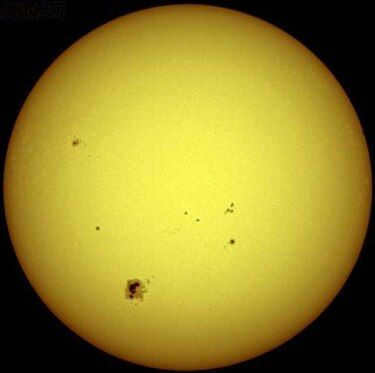 | |
| Photosphere · Chromosphere · Solar corona | ||
| Heliosphere (Heliospheric current layer · Shock wave boundary) · Heliospheric mantle · Heliopause · Head shock wave | ||
| Solar eclipse · Solar activity (Sunspots · Solar flares · Coronal mass ejections) · Solar radiation (Variations in solar radiation) · Coronal holes · Coronal loops · Flares · Granules · Floccules · Protuberances and fibers · Spicules · Supergranulation · Solar wind · Morton wave | ||
| Solar system · Solar dynamo · Stellar evolution | ||
| Spectral class: G2 | ||
Wikimedia Foundation. 2010.
Helpful
Discover the definition of “Solar wind” in other dictionaries:
- SOLAR WIND – an unchanging outward flow of plasma from the Sun’s corona into interplanetary space. The energy flow emanating from the Sun’s interior raises the temperature of the coronal plasma to 1.5-2 million K. The solar wind is an unchanging radial flow of the Sun’s corona plasma into interplanetary space. The post-heating is not offset by energy loss through radiation, as the corona’s density is low…. … Encyclopedia of Physics
- SOLAR WIND – The SOLAR WIND refers to the continuous flow of plasma from the solar corona that extends throughout the solar system, reaching up to 100 astronomical units from the Sun. At this distance, the dynamic pressure of the solar wind is balanced by the pressure exerted by the interstellar medium. The primary constituents of the solar wind are protons, electrons, and nuclei. This information is sourced from the Modern Encyclopedia.
- SOLAR WIND – The SOLAR WIND is a constant stream of charged particles, predominantly protons and electrons, that are propelled by the high temperatures present in the solar corona. These particles reach velocities that allow them to overcome the gravitational pull of the Sun. The solar wind also causes deflection in its path. This information is sourced from the Science and Technology Encyclopedic Dictionary.
- Solar wind – The solar wind is a flow of plasma from the Sun’s corona that extends throughout the solar system, reaching up to 100 astronomical units away from the Sun. At this distance, the pressure from the surrounding interstellar medium balances the force exerted by the solar wind. The primary constituents of the solar wind are protons, electrons, and nuclei… as described in the Illustrated Encyclopedic Dictionary.
- SOLAR WIND – The solar wind refers to the plasma released from the Sun’s corona into the space between planets. By the time it reaches the Earth’s orbit, the average velocity of the solar wind particles (protons and electrons) is approximately 400 km/s, with several tens of particles per cubic centimeter… as stated in the Large Encyclopedic Dictionary.
- SOLAR WIND – “SOLNECHNY VETER”, USSR, EKRAN (OSTANKINO), 1982, a color TV series. The protagonist of the show is Nadezhda Petrovskaya, a young scientist who tackles problems at the intersection of various scientific disciplines. This is the final work of actor Andrei Popov, who has played 39 roles in the series. In … … the Encyclopedia of Cinema
- Solar wind refers to the constant radial outflow of plasma from the solar corona (See Solar corona) into interplanetary space. The formation of the solar wind is linked to the energy flow from deeper layers of the Sun into its corona. It is believed that … … the Big Soviet Encyclopedia
- Solar wind is defined as the ejection of plasma from the solar corona into interplanetary space. The average velocity of solar wind particles (protons and electrons) at the Earth’s orbit is approximately 400 km/s, with the particle density ranging from a few units to a few tens in every cubic centimeter. * * * * * … … Encyclopedic Dictionary
- Solar wind refers to the stream of charged particles that emanate from the Sun. It primarily consists of fully or partially ionized hydrogen and helium, known as plasma, which travel at an average velocity… … … Universal Additional Practical Dictionary of I. Mostitsky. Mostitsky
- Solar wind is known as Saulės vėjas in Lithuanian. It is a term used in physics to describe the stream of charged particles emanating from the Sun. In English, it is also referred to as solar wind, in German as Sonnenwind, and in French as vent solaire… Fizikos terminų žodynas
Solar wind is an ion-saturated stream of particles that emanates from the Sun’s corona and extends into outer space. The velocity of these streams ranges from a minimum of 300 km/s to a maximum of 1200 km/s. This solar wind propagates throughout the interplanetary medium and is responsible for natural phenomena such as auroras, magnetic storms, and space weather. When referring to other stars, it is more appropriate to use the term “stellar wind.” However, when discussing the wind originating from the Sun, it is more accurate to call it “solar stellar wind.” It is important to note that the concepts of solar “wind” and “light” are fundamentally distinct. While the solar wind consists of particles that take 48-72 hours to reach Earth, sunlight is a stream of photons that reaches our planet’s atmospheric zone in just 8 minutes and 16 seconds.
Solar sails, also known as “electric sails” in the scientific community, harness the pressure of sunlight to provide energy for spacecraft in space. These devices have been instrumental in space exploration.
Unveiling the Origins of Solar Wind
The concept of particles emanating from our star was initially proposed by British scientist Richard Callington. In the late 19th century, Callington and his colleague R. Hodgson were the first to observe this phenomenon, now known as a solar flare. Approximately 24 hours later, they noticed a geomagnetic storm and Callington speculated that it was related to the previous event. Astronomer George Fitzgerald later hypothesized that the substance in question would reach Earth within a couple of days. Then, in 1916, Norwegian scientist K. Birkeland stated, “Based on the principles of physics, it is reasonable to assume that the rays of light do not carry any charge.” Birkeland was referring to the fact that the solar wind contains both negatively charged particles (electrons) and positively charged particles (ions). Shortly after, English scientist Friederick Lindemann proved that our star is the primary source of protons and electrons.
In 1959, Konstantin Gringauz conducted the initial analysis of the stellar wind using the Luna-1 instrument from the Soviet Union. The data was collected using a built-in scintillation counter and a specialized gas detector. Further comprehensive studies were carried out shortly after with the Mariner-2 spacecraft. However, the exact reason behind the acceleration of the wind to such high speeds remained partially unexplained. Physicists Pneuman and Knopp were the first to present models illustrating the behavior of stellar winds within the star’s corona.
During the 1990s, the SOHO satellite utilized its Ultraviolet Coronal Spectrometer to gather valuable information by examining specific regions where fast solar wind streams form. Analysis of the data obtained from this investigation revealed that the acceleration of these streams is significantly greater than previously anticipated.
Regarding wind speed according to Parker’s model, it only reaches supersonic levels at a distance of 4 solar radii from the solar photosphere. Studies conducted in space have shown that this increase in solar wind speed actually occurs at a smaller distance from the star’s photosphere, specifically only 1 solar radius away. These observations also confirmed the hypothesis that there is an additional mechanism influencing the acceleration of wind streams.
Main features of the solar wind
The heliospheric current sheet is a direct result of the impact of the magnetic field of the star on the plasma contained in the solar wind.
The solar wind flows consist primarily of protons, electrons, and helium nuclei. The composition of the solar wind is in no way affected by the fact that it originates from the outer layer of the Sun.
The primary factor that determines the strength of the stellar wind is its source and the level of activity exhibited by the star itself. There are two distinct types of solar wind, each characterized by their respective velocities: calm and turbulent. The calm flows are further categorized as either fast or slow. The fast flows, located closest to Earth, can reach speeds of 600-800 km/s, while the slower flows typically travel at around 400 km/s. Often, the stationary wind is characterized by the presence of a heliospheric current layer, which acts as a boundary between regions with different magnetic polarities in the interplanetary magnetic field. In terms of its qualitative characteristics, the stationary wind more closely resembles a slow wind rather than a fast wind.
Overview of the slow solar wind
The slow solar wind originates from a region of the solar corona that is in a state of hydrostatic balance. However, when the temperature exceeds 2-106 K, the corona can no longer maintain this balance, causing an increase in the velocity of its matter to supersonic speeds. The heating of the solar corona to such high temperatures is the result of processes occurring in the star’s photosphere. One example is the formation of convective turbulence, which leads to the concentration of extremely powerful magnetosonic waves. These waves penetrate into the less concentrated coronal layers, where they transform into shock waves. The coronal matter quickly neutralizes these shock waves, resulting in a temperature increase to (1-3)-106 K.
Fast solar wind streams can be emitted by the corona for extended periods of time. These streams are linked to coronal voids, which are characterized by relatively low temperatures (around 0.8-106 K) and extremely low plasma densities.
Perturbed solar wind streams
Perturbed solar wind streams are essentially the result of material being ejected from the corona. Observations have shown that about half of these streams are accompanied by a shock wave ahead of them. Only this type of solar wind is capable of causing a deviation in the magnetic field from the ecliptic plane. These deviations often lead to changes in space weather. It was previously believed that perturbed sporadic streams were caused by solar flares. However, scientists now believe that they are formed as a result of powerful coronal emissions.
It is important to note that solar flares have an impact on coronal ejections. Moreover, they share common sources of energy, and there is a statistical correlation between them.
When examining various forms of stellar wind on a large scale, researchers discovered that slow and fast streams account for only 53% of the overall total.
Phenomena resulting from the solar wind.
Due to the high conductivity of the plasma in stellar winds, the magnetic field collides with the jets of wind streams and is carried into the interplanetary medium, where it exists as an interplanetary magnetic field.
Solar winds also act as a barrier at the edges of the heliosphere, preventing interstellar gas from entering the solar system. The magnetic field of solar winds plays a role in scattering galactic cosmic rays. The localized increase in interplanetary magnetic field activity temporarily shields against various types of cosmic rays. Consequently, a significant decrease in field activity results in a decrease in the occurrence of this phenomenon.
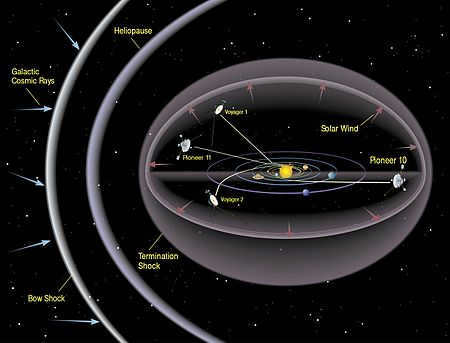
The heliosphere is a region in space close to the Sun where plasma from the solar wind moves faster than the speed of sound. On its outer edge, the heliosphere is surrounded by a shock wave that forms when the solar wind interacts with the interstellar plasma and magnetic field. [1]
For the initial 10 billion kilometers, the velocity of the solar wind is approximately one million kilometers per hour. [2] [3] As it encounters the interstellar medium, there is a decrease in speed and a blending with it. The boundary where the solar wind decelerates is referred to as the shock boundary, and the boundary where the pressure between the solar wind and the interstellar medium is balanced is known as the heliopause. Heliopause. The boundary where the interstellar medium collides with the incoming solar wind is called the heliopause. Head shock wave.
The concept of “heliosphere” is a specific example of a more general phenomenon, the astrosphere (and in the near future the only one available for study from within). In the English literature, the synonymous term “stellar wind bubble” may also be utilized for arbitrary stars.
The flow of particles and magnetic fields known as the solar wind originates from the ionized atoms in the solar corona. This solar wind forms a spiral shape as the Sun rotates, completing a revolution every 27 days. When the Earth crosses paths with this spiral, its own magnetic field interacts with the solar wind, potentially causing magnetic storms.
In March 2005, the findings from measurements conducted by SOHO were released. These measurements revealed that the region of space filled with solar wind does not possess perfect axial symmetry, but instead has a slightly distorted shape. This distortion is likely influenced by a local portion of the galactic magnetic field [4].
Structure [ edit edit code ]
Heliospheric current layer [ edit correct code ] .
Construction [ modify modify source ]
Heliospheric current layer [ modify amend source ] .
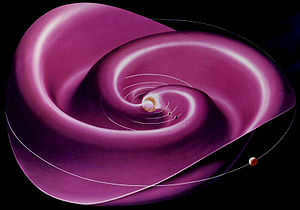
The heliospheric current layer, which is formed by the Sun’s magnetic field changing its polarity and rotating, is a distinctive feature of the heliosphere. This current layer, extending beyond the boundaries of the heliosphere, is the largest structure within the solar system. Its appearance can be likened to the layered skirt of a ballerina [5].
External composition [edit edit code].
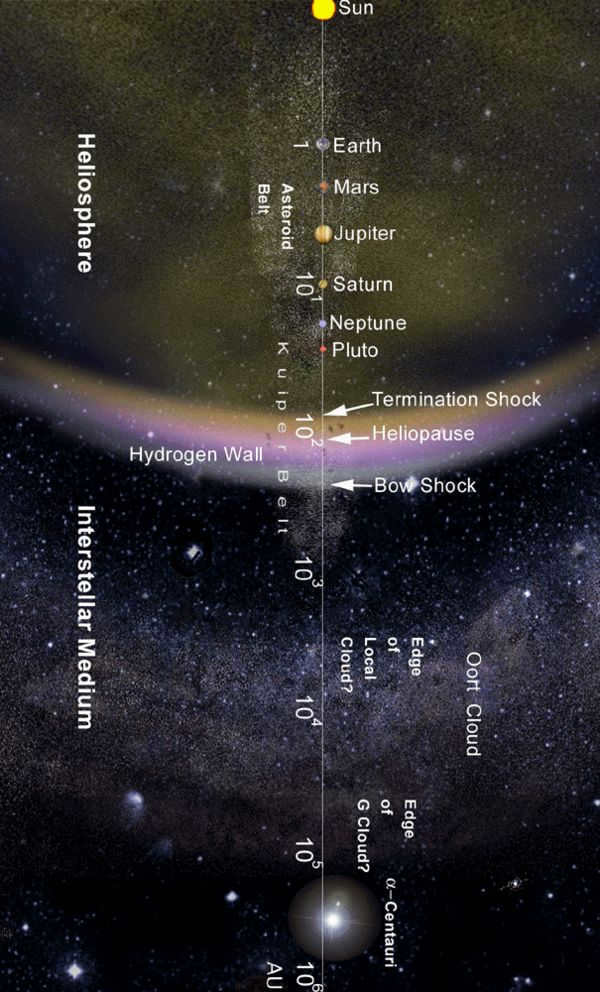
The structure of the heliosphere is shaped by the interaction between the solar wind and the particles in interstellar space. The solar wind flows outward in all directions from the Sun, reaching speeds of several hundred kilometers per second near the Earth. However, as it moves further away from the Sun, beyond the orbit of Neptune, the solar wind gradually slows down. This deceleration happens in multiple stages:
- Within the solar system, the solar wind travels at supersonic speeds. However, at a certain point known as the shock boundary, its speed decreases to sonic speeds.
- Once the solar wind loses its supersonic speed, it begins to interact with the surrounding interstellar matter. This interaction between the galactic matter and the Sun’s movement in it causes the heliosphere to assume a drop-shaped form, with its tail extending in the opposite direction of the Sun’s motion. This particular region of space is known as the heliospheric mantle (the mantle of the solar system).
- The heliopause is the surface that encloses the heliospheric mantle and serves as the final braking point for the solar wind. It is also where the solar wind mixes with the incoming interstellar matter. The heliopause represents the boundary of the entire heliosphere.
- The movement of the Sun within the interstellar medium causes disturbances in the encompassing interstellar space. Similar to how the solar wind diminishes in speed at the shock boundary, the interstellar wind that moves towards the Sun’s motion experiences a change in velocity at a comparable boundary known as the head shock. This boundary exists beyond the heliosphere, and it is the interstellar wind, not the solar wind, that decelerates in this region.
The shock boundary [ edit edit code ].
A visual demonstration of the shock boundary. The point at which the flow of water loses its energy and experiences a significant decrease in speed is known as the shock wave boundary
The shock boundary refers to the region within the heliosphere where the solar wind suddenly decelerates to sonic velocities (relative to the speed of the Sun itself). This occurs as the solar wind particles interact with interstellar matter. Within our solar system, it is estimated that the shock boundary is located approximately 75-90 astronomical units (about 11-13.5 billion kilometers) away [6]. In 2007, Voyager 2 successfully traversed the shock boundary [7] (in fact, it crossed it a total of five times, as the boundary is known to be variable and can shift in position due to fluctuations in solar activity and the amount of matter emitted by the Sun).
There are similar boundaries of shock waves that can be observed on Earth. An easy example is the behavior of a stream of water in a sink. When it hits the sink, the water jet spreads out in all directions at a speed that surpasses the speed at which mechanical waves propagate in water. This creates a thin disk of rapidly spreading water, similar to the supersonic flow of the solar wind. At the edges of this disk, a water shaft is formed, where the water flows at a slower speed than the propagation speed of mechanical waves.
Evidence presented by Ed Stone at the May 2005 meeting of the American Geophysical Union suggests that the Voyager 1 spacecraft crossed the shock boundary in December 2004, when it was 94 astronomical units from the Sun. This finding was based on the analysis of magnetic field readings obtained from the spacecraft. In a similar fashion, Voyager-2 detected the reverse motion of particles at a distance of 76 astronomical units in May 2006. These findings imply that the shape of the heliosphere is somewhat asymmetric, with the northern half being larger than the southern half [8].
The Interstellar Boundary Explorer satellite is set to gather additional data on the shock boundary.
The area beyond the boundary of shock is known as the heliopause, where the solar wind slows down and mixes with interstellar matter. Even further out is the heliopause, which is marked by the head shock. In June 2011, it was reported that Voyager research had found that the magnetic field at the boundary of the solar system has a structure resembling foam.
In June 2011, it was announced that the Voyager spacecraft had discovered that the magnetic field at the outer edge of the solar system has a foam-like structure. This is because magnetized matter and small cosmic objects create local magnetic fields that can be compared to bubbles [9].
Heliospheric mantle [ edit edit code ].
Modifying the Heliospheric Mantle [ edit code ]
Altering the Heliospheric Mantle [ edit code ]
Editing the Heliospheric Mantle [ edit code ]
Customizing the Heliospheric Mantle [ edit code ]
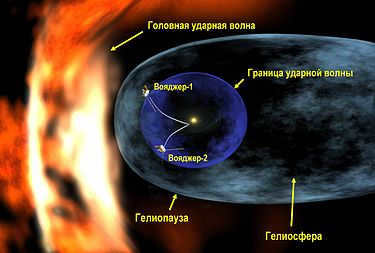
A diagram is shown that illustrates the location of Voyager 1 within the heliospheric mantle. It is worth noting that Voyager 2 is also currently situated in the same mantle.
The heliospheric mantle refers to the section of the heliosphere that lies beyond the shock wave. Within this region, the solar wind experiences a decrease in speed, becomes compressed, and its movement becomes turbulent. The heliospheric mantle extends from a distance of approximately 80-100 astronomical units away from the Sun. However, unlike the inner portion of the heliosphere, the mantle does not possess a spherical shape. Instead, it resembles an elongated comet coma that extends in the opposite direction of the Sun’s motion. The thickness of the mantle is significantly smaller on the side facing the interstellar wind collision compared to the opposite side [10]. The current mission of the Voyager spacecraft is to gather data on the characteristics of the heliospheric mantle.
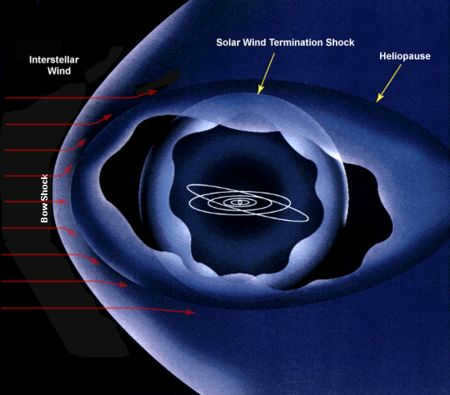
The heliopause is the point where the heliosphere meets the interstellar medium. When the solar wind reaches the heliopause, its speed drops significantly, causing a shock wave to form.
Heliopause is the hypothetical line where the solar wind slows down completely. At this point, the pressure from the solar wind is not strong enough to push interstellar matter out of the solar system, resulting in a mix of solar wind and interstellar matter.
Hypotheses [ edit edit code ]
One hypothesis suggests that there exists a region known as “the hydrogen wall” between the head shock wave and the heliopause. This region is filled with hot hydrogen and contains interstellar matter that has been compressed by its interaction with the heliosphere. When particles emitted by the Sun collide with particles of interstellar matter, they lose their velocity and convert kinetic energy into thermal energy, resulting in the creation of a region of heated gas.
Alternatively, we propose defining the heliopause as the magnetopause, which is the boundary that marks the outer limit of the solar magnetosphere and the beginning of the galactic magnetic field.
Observational data [edit edit code]
In December 2011, Voyager 1 was approximately 119 astronomical units (17.8 billion km) away from the Sun [12] and entered the region of stagnation, marking the final boundary that separates the spacecraft from interstellar space. The stagnation region is characterized by a significant magnetic field strength (with the induction having increased by nearly twice the previous values) – the pressure from charged particles originating from interstellar space causes the Sun’s magnetic field to compress. Additionally, the instrument recorded a notable increase in the abundance of high-energy electrons (by a factor of approximately 100), which infiltrate the Solar System from the interstellar space [12].
In the first half of 2012, Voyager 1 successfully reached the threshold of interstellar space. The sensors of the automated station documented a 25% increase in the levels of galactic cosmic rays, which are high-energy charged particles originating from the vast expanse of the interstellar medium. Additionally, the probe’s sensors registered a significant decline in the quantity of charged particles emanating from the Sun. These findings provided strong indications to the scientific community that Voyager 1 was rapidly approaching the heliospheric boundary and would imminently transition into the realm of interstellar space [13].
By the conclusion of August 2012, the spacecraft’s sensors detected a drastic reduction in the recorded particles of solar wind. Unlike previous occurrences of a similar nature, this time the downward trend persisted. Subsequently, in either 2012 or 2013, Voyager 1 successfully traversed beyond the heliosphere and ventured into the vast expanse of interstellar space [14] [15].
Modifying the head shock wave [ edit edit code ] .
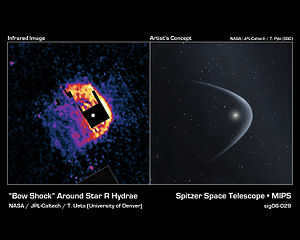
The hypothesis suggests that as the Sun travels through interstellar matter, it generates a shock wave that resembles the star shown in the image to the right. This shock wave takes on the shape of a paraboloid, similar to the wave that forms on the surface of water in front of a moving ship. This phenomenon occurs for the same reasons. If interstellar matter is moving towards the Sun at supersonic speeds, a head wave will occur. When this interstellar wind collides with the heliosphere, it decelerates and forms a shock wave, similar to the wave that forms within the heliosphere when the solar wind decelerates. NASA experts Robert Nemiroff and Jerry Bonnell propose that this solar head wave may exist at a distance of 230 astronomical units from the Sun [16].
According to a recent study based on data analysis from the IBEX probe, it is suggested that the shock wave may not actually exist at all [17]. The study found that the velocity of the heliosphere as it travels through the interstellar medium is not high enough for a shock wave to form, with a speed of 84 thousand km/h instead of the previously assumed 95 thousand. These findings are further supported by data from the Voyager spacecraft.
Meanwhile, observations from the GALEX orbiting telescope have revealed interesting phenomena surrounding the star Mira in the constellation Keith. It has been observed that Mira has a comet-like coma-like tail of ejected stellar matter, accompanied by a clearly visible head shock wave in the direction of the star’s motion through space, with a speed of 130 km/s.
Researching the heliosphere [ edit edit code ]
The heliosphere is being investigated by the Interstellar Boundary Explorer (IBEX) and the Voyagers. In 2009, data from IBEX was utilized to identify a massive ring that surrounds the complete heliospheric “bubble” [18].
Additional information [ edit edit code ].
Notes [ edit correct code ].
- ↑Astronet. Heliosphere
- ↑Dr. David H. Hathaway.The Solar Wind(The Solar Wind.) . NASA (January 18, 2007). Accessed December 11, 2007.Archived August 22, 2011.
- ↑Britt, Robert Roy. A Glowing Discovery at the Forefront of Our Plunge Through Space, SPACE.com (March 15, 2000). Archived January 11, 2001.Date of circulation May 24, 2006.
- ↑Lallement, R.; Quemerais, E.; Bertaux, J. L.; Ferron, S.; Koutroumpa, D.; Pellinen, R..Deflection of the Interstellar Neutral Hydrogen Flow Across the Heliospheric Interface // Science : journal. – 2005. – Vol. 307 , no. 5714 . – P. 1447-1449 . – DOI:10.1126/science.1107953. – PMID 15746421.
- ↑Nemiroff, R.; Bonnell, J.The Sun’s Heliosphere & Heliopause(unpublished). . Astronomy Picture of the Day (June 24, 2002). Accessed May 25, 2007.Archived August 22, 2011.
- ↑MIT instrument discovers unexpected findings at the outer edge of the solar system
- ↑Than, Ker. Voyager II detects the boundary of the solar system, CNN (May 24, 2006). Accessed May 25, 2007.
- ↑Voyagers discovered magnetic bubbles at the periphery of the solar system(unclear) . Lenta.ru (June 10, 2011). Accessed June 12, 2011.
- ↑Brandt, Pontus (February 27-March 2, 2007). “Imaging of the Heliospheric Boundary” (PDF). NASA Advisory Council Workshop on Science Associated with the Lunar Exploration Architecture: White PapersTempe, Arizona: Lunar and Planetary Institute. Checked 2007-05-25.
- ↑Wood, B. E.; Alexander, W. R.; Linsky, J. L..The Characteristics of the Local Interstellar Medium and the Interaction of the Stellar Winds of \epsilon Indi and \lambda Andromedae with the Interstellar Environment(unpublished) (link not available) . American Astronomical Society (July 13, 2006). Accessed May 25, 2007.Archived June 14, 2000.
- 12“Voyager 1 has arrived at the final frontier of our solar system”.(unpublished). . Science and Technology. Lenta.ru (December 6, 2011). Date of publication October 31, 2013.
- ↑The Voyager probe has now reached the outer edge of interstellar space(unpublished) . Science. RIA Novosti (June 15, 2012). Accessed on October 31, 2013.
- ↑Nancy Atkinson.Voyager 1 may have left our solar system . Universe Today (October 8, 2012). Accessed on October 29, 2013.
- ↑Ron Cowen.Voyager 1 has officially entered interstellar space (English) . News & Comment. Nature (September 12, 2013). Accessed on October 31, 2013.





